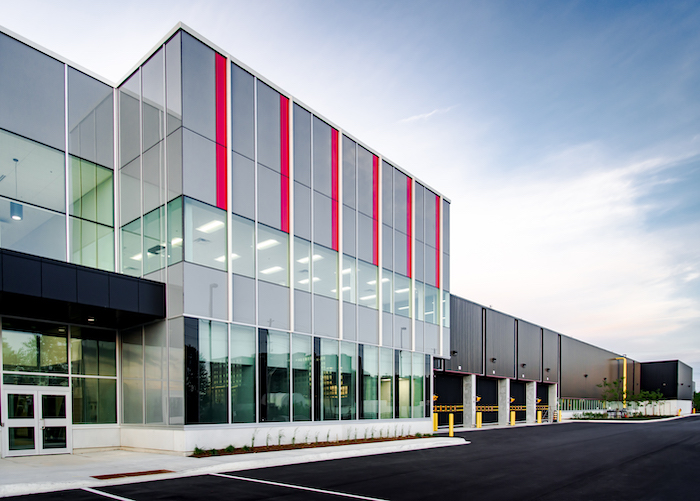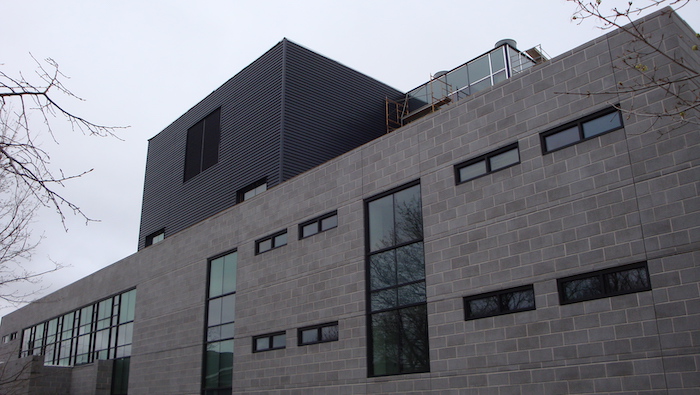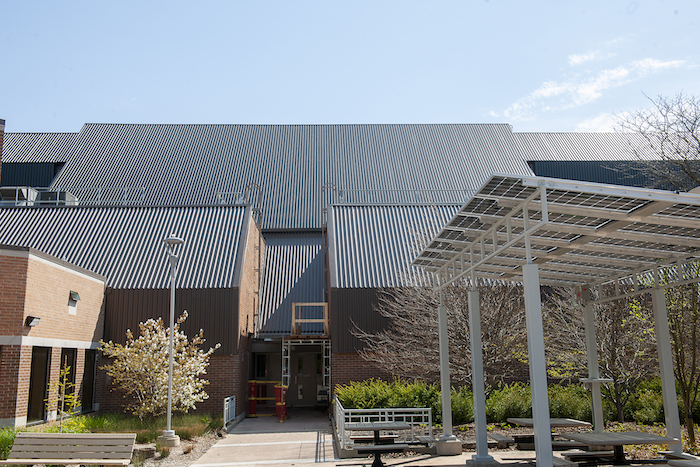
Balancing IAQ and energy efficiency via solar heating
December 15, 2020
By John Hollick, P.Eng.
With the COVID-19 pandemic, the paradigm is shifting for ventilation air.

The Toronto Transit Commission’s (TTC’s) McNicoll bus garage features 24,000 sf of solar air heating systems along its south and west elevations. Photo courtesy Strasman Architects.
Given its attention in mainstream media, political rhetoric, industry guidance and changing regulations, the focus on ventilation air has never been more prominent than it is now. For years, buildings have reduced their fresh air intake to help minimize energy consumption (and corresponding carbon emissions) and achieve better performance standards. This strategy, however, is now being challenged by the need to dramatically increase fresh air intake to improve indoor air quality (IAQ) and minimize the risk of indoor airborne transmission of the novel coronavirus.
This is an important discussion for consulting engineers and building designers to contemplate now—and there are ways to increase ventilation air intake without incurring a corresponding increase in energy costs and carbon emissions. One such option is the use of solar air heating.
“Solar heating of ventilation air has been used across North America for 30 years.”
No need for a trade-off
One example of this technology is the use of a perforated metal collector system to preheat ventilation air before it enters the fresh air side of a building’s HVAC unit. These systems can be mounted on a building’s wall or roof, sized to accommodate anywhere from 1 to 10 cfm of ventilation air per sf.
This technology has already been used extensively across North America over the past 30 years for many types of buildings, including schools, universities and colleges, and has allowed them to meet or exceed their required ventilation intake without increasing energy costs. Thus, there is no need for an energy efficiency trade-off when tacking the problem of COVID-19.

Halifax’s Dalhousie University uses solar air heating on the Mona Campbell Building to warm daytime ventilation when it is occupied. Photo courtesy Conserval Engineering.
ASHRAE recommendations
One of the prominent industry advocates in the media has been William P. Bahnfleth, professor of architectural engineering at Penn State University and chair of ASHRAE’s Epidemic Task Force.
“The U.S. Centers for Disease Control and Prevention (CDC) have stated airborne transmission of SARS CoV-2 can occur when there is inadequate ventilation indoors,” he explains. “This is corroborated by evidence from superspreader events. Multiple analyses of infection risk have concluded the combined effect of ventilation, filtration and air cleaners should be equivalent to four to six air changes per hour of outdoor air, although there is considerable uncertainty associated with these estimates. HVAC systems should be inspected to confirm they are bringing in at least the outdoor air supply required by a minimum design standard, such as ASHRAE 62.1.”
ASHRAE also released a position document on infectious aerosols, including the following recommendations:
- Disable demand-controlled ventilation and open outdoor air dampers up to 100%, as conditions permit, to eliminate recirculation.
- Keep HVAC systems running longer hours—if possible, 24-7.
- Bypass energy recovery ventilation systems that leak potentially contaminated exhaust air into the outdoor air supply.
Solar air heating systems are ideally suited to help meet all of these recommendations, as there are numerous ways to incorporate them into buildings’ mechanical ventilation systems.
“Analyses of infection risk have concluded the combined effect of ventilation, filtration and air cleaners should be equivalent to four to six air changes per hour of outdoor air.” – William P. Bahnfleth, ASHRAE Epidemic Task Force
“We have successfully incorporated solar air heating for multiple secondary school projects, including both new construction and upgrades,” says Robert Cenedese, principal at Rocky Point Engineering in Langley, B.C. “The original design intent of preheating demand-controlled ventilation air has proven to work effectively. Interestingly, an additional feature has been implemented through direct digital control (DDC) programming. When conditions permit, preheated solar air is used as first-stage heating for the spaces served, regardless of carbon dioxide (CO2) demand. Thereby, in addition to heating the spaces using free solar energy, the ventilation airflow rate increased, resulting in improved IAQ without increased energy consumption or carbon emissions. A true win-win!”
Case in point
Fanshawe College in London, Ont., is an example of a large campus that has implemented a greenhouse gas (GHG) reduction road map and action plan to ensure low-carbon buildings. The process included an ASHRAE Level 1 energy audit, with the goal of reducing GHG emissions by 30% between 2013 and 2030—and 50% by 2050.
The college found ventilation air heating was a significant contributor to its GHG emissions, due to the consumption of natural gas as a source of heat energy.
“The college was looking to reduce GHG emissions and saw energy harvesting through the use of solar air heating as an innovative yet natural technology that addressed this need,” says Nathan Gerber, Fanshawe’s energy co-ordinator. “This, along with the fact the technology could be used on an existing wall area, in an esthetically balanced if not pleasing way, provided a good opportunity for further investigation.”
The college went on to specify solar air heating for five of its buildings, with 11,000 sf of the systems applied to two residences and another 21,000 sf for three other buildings. The systems were integrated into multiple walls for these applications, supplying several rooftop air handling units (AHUs). Today, in total, they condition 115,000 cfm of ventilation air while avoiding the consumption of 152,000 m3 of natural gas per year, emissions of 286 t of CO2 per year—5.3% of the college’s total emissions—and the use of 1,530 MWh of energy per year.
“The goals of the initiative were to reduce GHG emissions, provide learning and research opportunities for staff and students and address deferred maintenance needs in some of our older buildings,” says Gerber. “Now, since the arrival of COVID-19 and its actual and potential implications on IAQ, ventilation loads have increased, resulting in an even greater impact on GHG emission production and subsequent potential avoidance through solar radiation harvesting.”

Fanshawe College in London, Ont., has integrated solar air heating systems alongside other metal wall cladding systems for its main common building, in an effort to keep the exterior design visually pleasing. Photo courtesy Fanshawe College.
Transforming thinking
In a similar fashion to how the Leadership in Energy and Environmental Design (LEED) rating system transformed thinking on energy performance for buildings, so now will COVID-19 transform thinking on the ‘health’ of buildings.
“Since the arrival of COVID-19, our ventilation loads have increased.”- Nathan Gerber, Fanshawe College
That is to say, it will reinforce the need to design and operate buildings that not only meet energy standards, but also meet health standards for an indoor environment with plenty of ventilation air.
Different technologies will play a role in helping to achieve both goals, including solar air heating systems, for institutional, commercial, industrial and multi-tenant residential buildings.
John Hollick, P.Eng., is president of Conserval Engineering and inventor of SolarWall unglazed transpired collector technology for solar air heating.